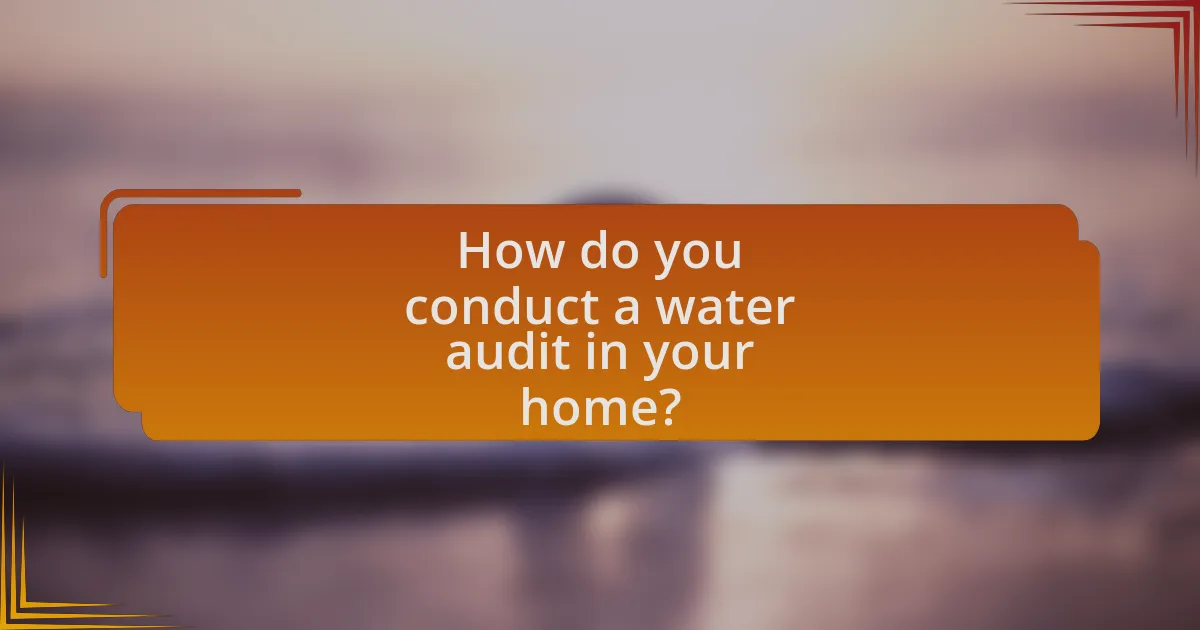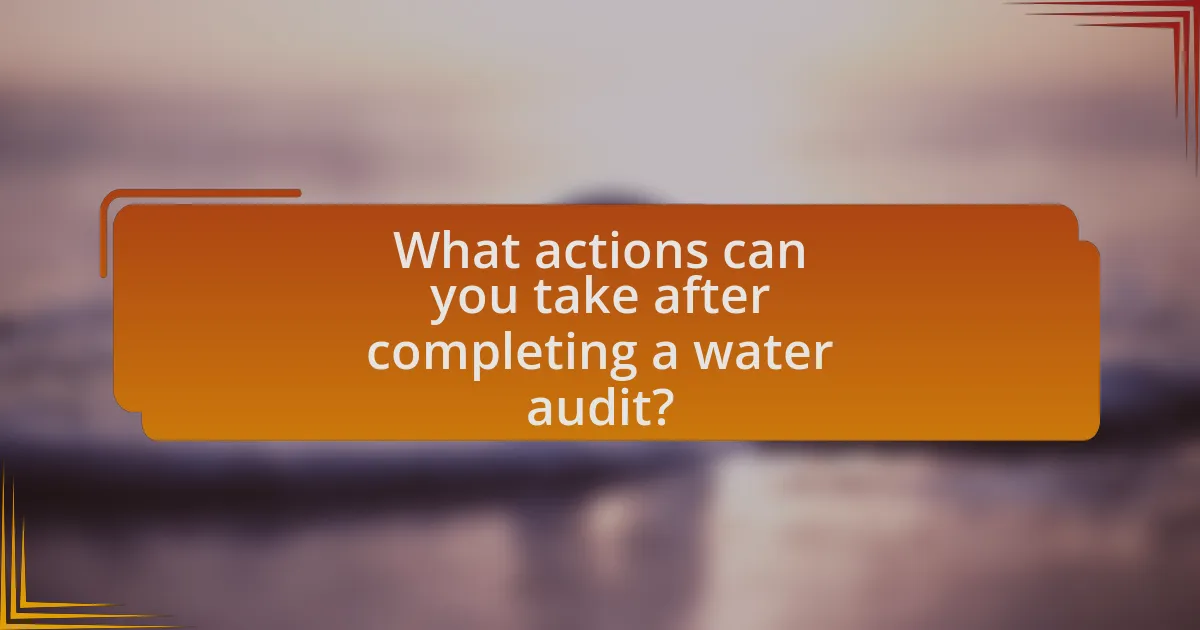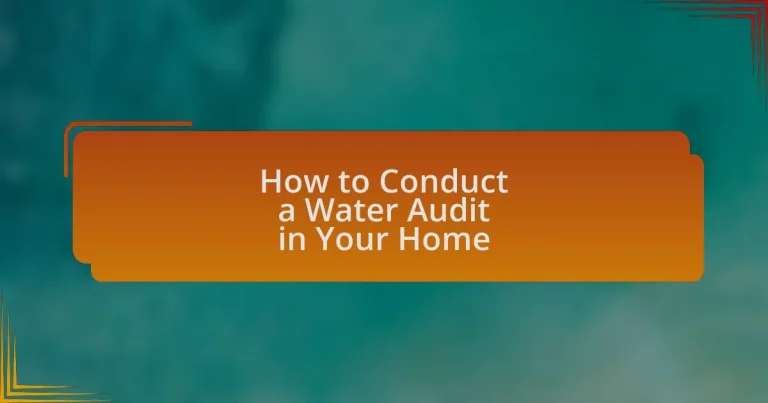A water audit is a systematic evaluation of water usage in homes or facilities aimed at identifying conservation opportunities and improving efficiency. This article outlines the importance of conducting a water audit for homeowners, detailing its environmental and financial benefits, such as reducing water waste and lowering utility bills. Key components of a water audit include assessing water usage, detecting leaks, evaluating fixtures, and identifying conservation measures. The article also provides practical steps for conducting a water audit, tools needed, methods for leak detection, and best practices for ongoing water conservation efforts. By implementing the findings from a water audit, homeowners can significantly enhance their water management and contribute to environmental sustainability.
What is a Water Audit?

A water audit is a systematic assessment of water usage within a facility or home to identify areas for conservation and efficiency improvements. This process typically involves measuring water consumption, analyzing usage patterns, and evaluating the effectiveness of existing water management practices. According to the U.S. Environmental Protection Agency, conducting a water audit can help reduce water waste by up to 30%, leading to significant cost savings and environmental benefits.
Why is conducting a water audit important for homeowners?
Conducting a water audit is important for homeowners because it helps identify water usage patterns and potential leaks, leading to more efficient water management. By assessing water consumption, homeowners can uncover areas where water is wasted, which can result in lower utility bills and conservation of this vital resource. Studies indicate that households can save up to 20% on their water bills by implementing changes based on audit findings, highlighting the financial and environmental benefits of regular water audits.
What are the environmental benefits of a water audit?
A water audit provides significant environmental benefits by identifying areas of water waste and promoting conservation practices. By assessing water usage, a water audit helps reduce unnecessary consumption, which can lead to lower energy use for water heating and distribution. For instance, the U.S. Environmental Protection Agency states that fixing leaks can save an average household about 10,000 gallons of water annually, which contributes to the preservation of local water resources. Additionally, reducing water waste decreases the demand on wastewater treatment facilities, thereby minimizing energy consumption and greenhouse gas emissions associated with water processing.
How can a water audit save money on utility bills?
A water audit can save money on utility bills by identifying leaks, inefficiencies, and areas for conservation within a household’s water usage. By systematically assessing water consumption patterns and fixtures, homeowners can pinpoint excessive water use, which often leads to higher bills. For instance, the U.S. Environmental Protection Agency estimates that fixing leaks can save homeowners about 10% on their water bills. Additionally, implementing water-saving fixtures and practices identified during the audit can further reduce consumption, leading to significant long-term savings.
What are the key components of a water audit?
The key components of a water audit include water usage assessment, leak detection, fixture evaluation, and water conservation opportunities. A water usage assessment involves analyzing water bills and consumption patterns to identify trends and anomalies. Leak detection focuses on identifying and quantifying leaks in plumbing systems, which can significantly impact water waste. Fixture evaluation examines the efficiency of faucets, toilets, and irrigation systems to determine their water usage and potential for upgrades. Lastly, identifying water conservation opportunities involves recommending practices or technologies that can reduce overall water consumption, such as low-flow fixtures or rainwater harvesting systems. These components collectively help in understanding and improving water efficiency in a home.
What tools and resources are needed for a water audit?
A water audit requires specific tools and resources to effectively assess water usage. Essential tools include a water meter to measure consumption, a flow rate calculator to determine the efficiency of fixtures, and leak detection equipment to identify leaks in plumbing systems. Additionally, resources such as water usage records, manufacturer specifications for appliances, and a checklist for evaluating water fixtures and landscaping are crucial for a comprehensive audit. These tools and resources enable accurate data collection and analysis, ensuring a thorough understanding of water usage patterns and potential areas for conservation.
How do you identify water usage areas in your home?
To identify water usage areas in your home, start by inspecting all water fixtures and appliances, including faucets, toilets, showers, and washing machines. Each of these fixtures contributes to overall water consumption, and their usage can be tracked through water bills or by using a water meter. For example, the average toilet uses about 1.6 gallons per flush, while a showerhead can use 2.5 gallons per minute. Monitoring these fixtures over a week can provide insights into which areas consume the most water. Additionally, checking for leaks, which can waste up to 10,000 gallons of water annually in a typical household, is crucial for accurate identification of water usage areas.
How do you conduct a water audit in your home?

To conduct a water audit in your home, start by checking your water meter to establish a baseline reading. This involves recording the meter’s current reading, then turning off all water sources and checking the meter again after a few hours; if the reading has changed, you likely have a leak. Next, inspect all faucets, toilets, and appliances for leaks or drips, as these can waste significant amounts of water. Additionally, review your water bills over the past year to identify any unusual spikes in usage, which can indicate inefficiencies. Finally, consider using a water audit checklist or calculator available from local water utilities to assess your water usage patterns and identify areas for improvement.
What are the steps involved in performing a water audit?
The steps involved in performing a water audit include identifying water sources, measuring water usage, inspecting plumbing fixtures, analyzing water bills, and implementing conservation measures. First, identify all water sources in the home, such as faucets, toilets, and irrigation systems. Next, measure the water usage by recording flow rates and monitoring usage over time. Inspect plumbing fixtures for leaks and inefficiencies, as these can significantly impact water consumption. Analyze water bills to understand usage patterns and identify any anomalies. Finally, implement conservation measures based on the findings, such as fixing leaks, installing low-flow fixtures, and adjusting irrigation schedules to reduce overall water consumption.
How do you collect data on water usage?
To collect data on water usage, homeowners can utilize water meters, which measure the volume of water consumed over time. These meters provide accurate readings that can be recorded daily, weekly, or monthly to track usage patterns. Additionally, homeowners can conduct a visual inspection of plumbing fixtures and appliances to identify leaks and inefficiencies, which can contribute to excessive water use. According to the U.S. Environmental Protection Agency, fixing leaks can save homeowners about 10,000 gallons of water annually. This combination of meter readings and inspections allows for a comprehensive understanding of water consumption in the home.
What methods can be used to detect leaks in your plumbing?
Methods to detect leaks in plumbing include visual inspections, listening for sounds of running water, using a water meter, and employing specialized leak detection equipment. Visual inspections involve checking for water stains, mold, or damp spots on walls and ceilings, which indicate potential leaks. Listening for sounds of running water when all fixtures are off can reveal hidden leaks. Utilizing a water meter allows homeowners to monitor usage; a significant increase without additional water use suggests a leak. Specialized leak detection equipment, such as acoustic sensors or infrared cameras, can accurately locate leaks within walls or underground. These methods are effective in identifying plumbing leaks, helping to prevent water damage and conserve water.
How can you analyze the data collected during a water audit?
To analyze the data collected during a water audit, one should categorize the data into relevant sections such as usage patterns, leak detection, and appliance efficiency. This categorization allows for a systematic review of water consumption trends, identifying areas of excessive use or potential waste. For instance, comparing monthly water bills can reveal spikes in usage that may indicate leaks or inefficiencies. Additionally, using tools like flow rate measurements and water meter readings can quantify the performance of fixtures and appliances, providing concrete data for further analysis. By employing statistical methods, such as calculating averages and identifying outliers, one can derive actionable insights to improve water conservation efforts.
What patterns should you look for in your water usage data?
You should look for trends in your water usage data, such as consistent spikes in consumption, seasonal variations, and discrepancies between estimated and actual usage. Identifying consistent spikes may indicate leaks or inefficiencies, while seasonal variations can help you understand usage patterns related to weather or activities. Discrepancies between estimated and actual usage can reveal inaccuracies in billing or metering. Analyzing these patterns can lead to actionable insights for reducing water waste and improving efficiency.
How do you compare your water usage to average household consumption?
My water usage is typically lower than the average household consumption, which is about 300 gallons per day for a family of four. By implementing water-saving practices such as fixing leaks, using efficient appliances, and reducing outdoor watering, my household averages around 200 gallons per day. This reduction aligns with findings from the U.S. Environmental Protection Agency, which states that efficient water use can save households up to 20% on their water bills, demonstrating the effectiveness of conservation efforts.
What actions can you take after completing a water audit?

After completing a water audit, you can implement water-saving measures based on the findings. These measures may include fixing leaks, installing low-flow fixtures, and adjusting irrigation systems to reduce water waste. For instance, the U.S. Environmental Protection Agency states that fixing leaks can save homeowners about 10% on their water bills. Additionally, replacing standard showerheads with low-flow models can reduce water usage by up to 40%, according to the American Water Works Association.
What are the best practices for reducing water consumption?
The best practices for reducing water consumption include fixing leaks, installing water-efficient fixtures, and adopting mindful water usage habits. Fixing leaks can save homeowners approximately 10,000 gallons of water annually, as reported by the U.S. Environmental Protection Agency. Installing low-flow showerheads and faucets can reduce water flow by 30% or more, significantly lowering overall consumption. Additionally, practices such as turning off the tap while brushing teeth and using a broom instead of a hose for cleaning driveways contribute to water conservation efforts. These strategies collectively lead to substantial reductions in water usage, promoting sustainability and cost savings.
How can you implement water-saving fixtures and appliances?
To implement water-saving fixtures and appliances, replace existing fixtures with low-flow options such as showerheads, faucets, and toilets that are designed to use less water without sacrificing performance. For example, low-flow showerheads can reduce water usage by up to 50%, while dual-flush toilets can save approximately 20% more water compared to standard models. Additionally, consider installing water-efficient appliances like Energy Star-rated dishwashers and washing machines, which use significantly less water per cycle. According to the U.S. Environmental Protection Agency, replacing older appliances with water-efficient models can save a family of four up to 20,000 gallons of water annually.
What maintenance tips can help prevent future water waste?
Regular maintenance of plumbing systems and appliances is essential to prevent future water waste. Homeowners should routinely inspect pipes, faucets, and toilets for leaks, as even small leaks can waste significant amounts of water over time; for instance, a dripping faucet can waste over 3,000 gallons per year. Additionally, homeowners should ensure that irrigation systems are functioning properly and are not overwatering lawns or gardens, which can lead to unnecessary water loss. Regularly cleaning aerators and showerheads can also improve water efficiency, as mineral buildup can restrict flow and lead to increased water usage. Implementing these maintenance tips can significantly reduce water waste and promote efficient water use in the home.
How can you track the effectiveness of your water-saving measures?
To track the effectiveness of your water-saving measures, regularly monitor your water usage through meter readings and compare them to previous periods. This method provides a clear quantitative assessment of water consumption changes over time. For instance, if your water bill shows a decrease after implementing measures such as low-flow fixtures or rainwater harvesting, it indicates successful water conservation. Additionally, keeping a log of daily or weekly water usage can help identify trends and areas for further improvement, reinforcing the impact of your conservation efforts.
What tools can help monitor ongoing water usage?
Smart water meters are effective tools for monitoring ongoing water usage. These devices provide real-time data on water consumption, allowing homeowners to track usage patterns and identify leaks. According to the U.S. Environmental Protection Agency, smart water meters can reduce water usage by up to 15% by providing users with detailed insights into their consumption habits. Additionally, mobile applications linked to these meters can send alerts for unusual usage, further aiding in water management.
How often should you conduct follow-up water audits?
Follow-up water audits should be conducted annually. This frequency allows homeowners to effectively monitor water usage, identify leaks, and assess the impact of any conservation measures implemented since the last audit. Regular annual audits are supported by the Environmental Protection Agency, which recommends periodic assessments to ensure ongoing water efficiency and conservation efforts.
What common challenges might you face during a water audit?
Common challenges during a water audit include data collection difficulties, inaccurate measurements, and lack of stakeholder engagement. Data collection can be hindered by inaccessible plumbing systems or incomplete records, making it hard to assess water usage accurately. Inaccurate measurements may arise from faulty meters or improper techniques, leading to misleading conclusions about water consumption. Additionally, engaging stakeholders, such as family members or tenants, can be challenging if they are not cooperative or aware of the audit’s importance, which can affect the overall effectiveness of the audit process.
How can you overcome difficulties in identifying leaks?
To overcome difficulties in identifying leaks, utilize advanced detection methods such as acoustic leak detection, thermal imaging, and moisture meters. These technologies enhance the accuracy of leak identification by allowing for the detection of sound waves, temperature variations, and moisture levels that indicate leaks. For instance, studies have shown that thermal imaging can detect temperature differences as small as 0.1 degrees Celsius, which is crucial for identifying hidden leaks behind walls or underground. Additionally, regular maintenance and monitoring of plumbing systems can prevent leaks from developing, as proactive measures reduce the likelihood of significant water loss.
What should you do if you find unexpected high water usage?
If you find unexpected high water usage, first check for leaks in your plumbing system, as they are a common cause of increased water consumption. Inspect faucets, toilets, and pipes for any signs of dripping or water accumulation. Additionally, review your water meter readings to identify any discrepancies between your usage and the meter’s recorded data. If leaks are not present, consider evaluating your household habits, such as excessive watering of lawns or frequent use of appliances. According to the Environmental Protection Agency, household leaks can waste more than 1 trillion gallons of water annually in the U.S., highlighting the importance of addressing unexpected high water usage promptly.
What are some practical tips for conducting a successful water audit?
To conduct a successful water audit, start by gathering all water bills for at least the past year to establish a baseline for water usage. This data helps identify trends and potential leaks. Next, inspect all plumbing fixtures, including faucets, toilets, and irrigation systems, for leaks or inefficiencies, as leaks can waste significant amounts of water—up to 10,000 gallons per year for an average household. Additionally, measure the flow rate of faucets and showerheads using a container and a stopwatch to determine if they meet efficiency standards; for example, a flow rate exceeding 2.5 gallons per minute for showerheads may indicate a need for replacement. Finally, document all findings and create an action plan to address any inefficiencies, which can lead to water conservation and cost savings.


